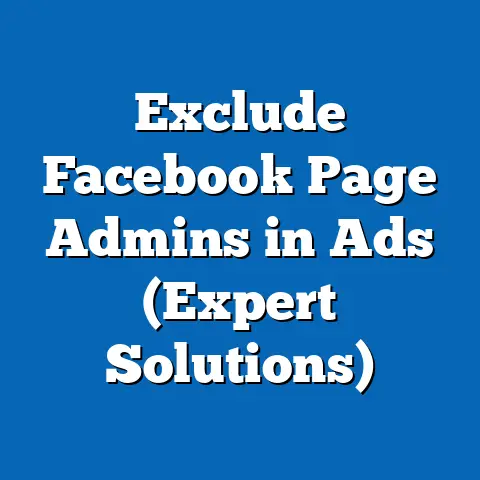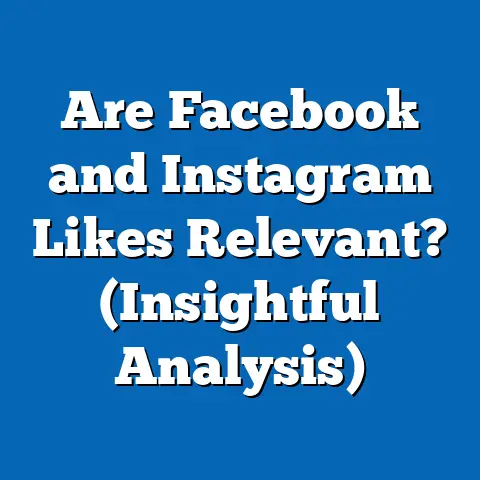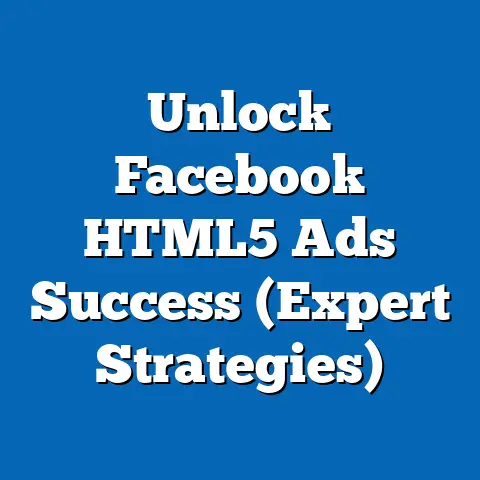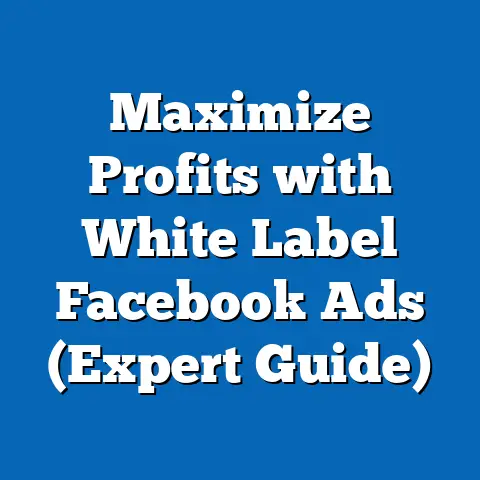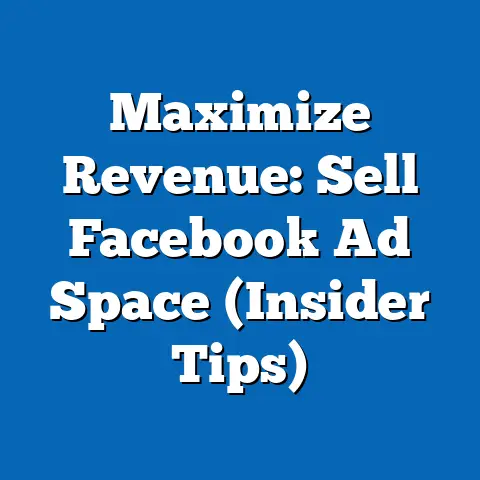Say Goodbye to Ineffective Facebook Ads (Proven Strategies)
Facebook advertising, once hailed as the golden ticket to reaching vast, targeted audiences, has become a frustrating enigma for many marketers in 2023. With over 2.9 billion monthly active users as of Q2 2023 (Statista, 2023), the platform remains a juggernaut in digital marketing, but its ever-evolving algorithms, rising costs, and shifting user behaviors have rendered traditional ad strategies obsolete. The days of throwing money at boosted posts and hoping for viral success are over—today’s marketers must adapt or risk wasting budgets on ineffective campaigns.
This article dives deep into the historical context of Facebook advertising, exploring how it transformed from a nascent tool in the late 2000s into a cornerstone of digital marketing. It examines the societal implications of these changes, including the growing demand for privacy, the impact of generational shifts on ad engagement, and the economic pressures driving advertisers to seek better ROI. By unpacking proven strategies grounded in data and expert insights, this piece aims to guide marketers through the complexities of modern Facebook advertising, ensuring their campaigns resonate in an increasingly competitive landscape.
Historical Context: The Rise and Evolution of Facebook Ads
Facebook launched its first advertising platform in 2007 with “Facebook Flyers,” a rudimentary system allowing businesses to promote events and products to specific user groups. This was a time when social media was still a novel concept, and MySpace dominated the landscape—Facebook’s user base was a modest 20 million compared to today’s billions (Facebook, 2007). The introduction of the News Feed in 2006 and subsequent ad integration marked a turning point, as businesses began to see the potential of reaching users in a personalized, non-intrusive way.
By 2012, Facebook had rolled out its modern advertising suite, including sponsored posts and targeted ads based on user data. This era coincided with the platform’s IPO and a mobile-first shift, reflecting broader societal trends toward smartphone adoption—Pew Research noted that 35% of Americans owned smartphones in 2011, a figure that surged to 81% by 2019. Marketers flocked to Facebook as ad costs were low (averaging $0.25 per click in 2010, per WordStream) and organic reach was high, often exceeding 16% for business pages.
However, the 2018 Cambridge Analytica scandal exposed the dark side of data-driven advertising, sparking public outcry over privacy violations. This event, coupled with Apple’s 2021 iOS 14 update limiting data tracking, forced Facebook to rethink its ad model. Ad costs skyrocketed—CPM (cost per thousand impressions) rose by 89% between 2020 and 2022 (Social Media Today, 2022)—while organic reach plummeted to under 5% for most pages. These shifts reflect a broader societal push for transparency and control over personal data, challenging advertisers to innovate beyond reliance on hyper-targeted ads.
Societal Implications: Privacy, Generational Shifts, and Economic Pressures
The evolution of Facebook advertising mirrors profound societal changes, particularly in how different generations interact with technology and advertising. Gen Z (born 1997–2012), now a key demographic with $360 billion in spending power (Bloomberg, 2023), is notoriously skeptical of traditional ads, prioritizing authenticity and value-driven content on platforms like TikTok over Facebook. Meanwhile, Millennials (born 1981–1996), who grew up alongside social media’s rise, remain active on Facebook but demand personalized, relevant messaging—63% report ignoring irrelevant ads (HubSpot, 2022).
Privacy concerns cut across generations, fueled by high-profile data breaches and regulatory responses like the GDPR in Europe and CCPA in California. A 2023 Pew Research survey found that 74% of Americans worry about how companies use their data, a sentiment that directly impacts trust in platforms like Facebook. For advertisers, this means navigating a landscape where users are more likely to opt out of tracking, reducing the effectiveness of once-reliable targeting tools.
Economically, the rising cost of Facebook ads—coupled with global inflation and tightened marketing budgets post-COVID-19—has placed immense pressure on businesses to justify every dollar spent. Small businesses, which make up 90% of Facebook’s 10 million active advertisers (Facebook, 2023), are particularly vulnerable, often lacking the resources to compete with larger brands for ad space. The societal ripple effect is clear: ineffective advertising can stifle growth for small enterprises, widen economic disparities, and reshape competitive dynamics in digital marketplaces.
Defining the Problem: Why Traditional Facebook Ads Fail
Before diving into solutions, it’s critical to understand why so many Facebook ad campaigns fall short in today’s environment. First, the platform’s algorithm prioritizes user experience over ad visibility, meaning content that fails to engage within seconds is deprioritized. A 2022 study by Hootsuite found that the average user spends just 1.7 seconds viewing a post before scrolling past—ads must capture attention instantly or risk being ignored.
Second, audience fatigue is rampant. With users bombarded by an estimated 6,000–10,000 ads daily across platforms (Forbes, 2021), generic messaging no longer cuts through the noise. Over-reliance on outdated tactics like broad targeting or static imagery exacerbates this issue, as does neglecting mobile optimization—over 98% of Facebook users access the platform via mobile devices (Statista, 2023).
Finally, the post-iOS 14 era has crippled data-driven targeting. Apple’s App Tracking Transparency (ATT) framework, which requires user consent for tracking, led to a reported $10 billion revenue loss for Meta in 2022 alone (CNBC, 2022). Marketers accustomed to granular audience segmentation now struggle to replicate past successes, often wasting budgets on poorly defined audiences. These challenges underscore the need for a strategic overhaul in how Facebook ads are conceptualized and executed.
Proven Strategies for Effective Facebook Advertising
The following sections outline data-backed, actionable strategies to transform ineffective Facebook ads into high-performing campaigns. These approaches account for current platform dynamics, user behavior, and generational nuances, ensuring relevance across diverse audiences.
1. Embrace Hyper-Relevant, Value-Driven Content
Modern Facebook users, especially younger demographics like Gen Z, gravitate toward content that aligns with their values or solves real problems. A 2023 Sprout Social report revealed that 70% of consumers feel more connected to brands whose content reflects social or environmental responsibility. Instead of hard-selling, focus on storytelling—use ads to highlight customer testimonials, behind-the-scenes content, or community impact initiatives.
For example, a small eco-friendly apparel brand might create a video ad showcasing how its products are made sustainably, paired with a clear call-to-action (CTA) like “Join Our Green Movement.” Such content not only engages but also builds trust, countering privacy skepticism. Test different messaging angles through A/B testing to identify what resonates most with your audience, and prioritize dynamic formats like video or carousel ads, which drive 20–30% higher engagement rates (WordStream, 2023).
2. Leverage Advanced Audience Targeting Alternatives
While traditional targeting options have been curtailed, Facebook still offers powerful tools like Lookalike Audiences and Custom Audiences based on first-party data. Lookalike Audiences allow advertisers to reach users similar to their best customers, using data from website visitors or email lists. A 2022 case study by Shopify showed that businesses using Lookalike Audiences saw a 2.5x increase in conversion rates compared to broad targeting.
Additionally, focus on interest-based and behavioral targeting to refine reach without relying on invasive data collection. For instance, a fitness brand could target users interested in “yoga” or “home workouts” while layering demographic filters like age or location. Post-iOS 14, it’s also wise to diversify data sources—integrate CRM data or pixel-based retargeting to maintain precision. As expert marketer Mari Smith advises, “The future of targeting is about creativity with constraints—use what’s available smarter, not harder.”
3. Optimize for Mobile-First Engagement
Given that nearly all Facebook users access the platform via mobile, ads must be designed for small screens and short attention spans. Use vertical video formats (9:16 ratio) for Stories and Reels, as they occupy more screen real estate and drive 35% higher click-through rates than horizontal formats (Facebook Business, 2023). Ensure text is minimal and legible—Facebook recommends keeping text under 20% of an image to avoid delivery penalties.
Speed is equally critical. Ads with fast-loading creatives see 70% higher conversion rates (Google, 2022), so compress images and avoid heavy graphics. Test interactive elements like polls or swipe-up features in Stories to boost engagement, particularly with younger users who favor gamified content. A mobile-first mindset isn’t optional—it’s the baseline for relevance in today’s ad ecosystem.
4. Invest in Video and Interactive Formats
Video content reigns supreme on Facebook, accounting for 50% of user time spent on the platform (Meta, 2023). Short, punchy videos (15–30 seconds) that convey a message upfront perform best, especially for capturing Gen Z and Millennial attention. A 2023 Vidyard study found that videos with a clear CTA in the first 10 seconds achieve 77% higher completion rates.
Beyond standard videos, experiment with interactive formats like Instant Experiences (formerly Canvas ads), which allow users to explore a brand’s story through immersive, full-screen content. For example, a travel agency might use an Instant Experience to showcase destinations with embedded booking links, reducing friction in the customer journey. These formats not only engage but also provide valuable data on user interactions, helping refine future campaigns.
5. Prioritize Retargeting and Customer Retention
Acquiring new customers through Facebook ads is increasingly expensive—customer acquisition costs rose by 60% from 2019 to 2023 (HubSpot, 2023). Retargeting, which focuses on users who’ve already interacted with your brand, offers a cost-effective alternative, often yielding 3x higher conversion rates (AdRoll, 2022). Use the Facebook Pixel to track website visitors and serve tailored ads, such as reminding cart abandoners to complete their purchase with a limited-time discount.
Equally important is nurturing existing customers. Create ads promoting loyalty programs or exclusive offers for past buyers, as retaining customers costs 5–7 times less than acquiring new ones (Bain & Company, 2021). For small businesses, this strategy maximizes limited budgets while fostering long-term relationships—a critical edge in a crowded market.
6. Test, Analyze, and Iterate Relentlessly
The unpredictability of Facebook’s algorithm demands a culture of continuous testing. Allocate 10–20% of your budget to experimenting with different ad creatives, copy variations, and audience segments. Use Facebook’s Ad Manager to track metrics like click-through rate (CTR), cost per conversion, and relevance score, adjusting campaigns in real time based on performance.
A/B testing is particularly effective for isolating variables—test one element at a time (e.g., headline or image) to pinpoint what drives results. As digital marketing expert Neil Patel notes, “Data is your compass in the chaos of social advertising—ignore it at your peril.” Regularly review insights to stay ahead of trends, such as seasonal shifts in user behavior or emerging content preferences among different generations.
Generational Nuances: Tailoring Ads for Diverse Audiences
While the above strategies apply broadly, generational differences significantly influence ad effectiveness. Gen Z, for instance, values authenticity and humor, often engaging with meme-style content or influencer partnerships—72% trust peer recommendations over traditional ads (Morning Consult, 2023). Ads targeting this group should feel organic, avoiding overt sales pitches in favor of relatable, snackable content.
Millennials, balancing career and family priorities, respond well to convenience-driven messaging. Highlight time-saving products or services, and use nostalgia to evoke emotional connections—think throwbacks to 90s pop culture. Baby Boomers (born 1946–1964), though less active on Facebook than younger cohorts, still represent a lucrative market with high disposable income. Focus on trust-building elements like clear value propositions and testimonials, as 68% prioritize credibility in purchase decisions (Nielsen, 2022).
Gen X (born 1965–1980), often overlooked, bridges the digital-native and analog worlds. They appreciate straightforward, no-nonsense ads that respect their time, with a preference for detailed information over flashy visuals. Across all groups, avoid stereotyping—diversity within generations means testing and personalization remain key to avoiding alienation.
Implications for Businesses and Society
The shift from ineffective to strategic Facebook advertising carries far-reaching implications. For businesses, mastering these strategies can level the playing field, allowing small enterprises to compete with larger brands through creativity rather than budget. Enhanced ad relevance also improves user experience, potentially rebuilding trust in a platform criticized for intrusive practices.
In the workplace, the demand for digital marketing expertise is surging—LinkedIn reports a 25% increase in job postings for social media specialists from 2021 to 2023. This trend underscores the need for upskilling, as companies prioritize employees who can navigate complex ad ecosystems. Culturally, the move toward value-driven content may push brands to align more visibly with social causes, influencing public discourse on issues like sustainability or equity.
Economically, efficient advertising supports small business growth, fostering innovation and job creation. However, rising ad costs risk excluding under-resourced players, potentially concentrating market power among big spenders. Policymakers and platforms like Meta must balance profitability with accessibility to prevent widening inequalities in the digital economy.
Challenges and Limitations
Despite the promise of these strategies, challenges persist. Algorithm changes remain unpredictable—Meta’s focus on Reels in 2022, for instance, deprioritized other formats overnight, frustrating advertisers. Budget constraints also limit testing for smaller businesses, while privacy regulations continue to evolve, potentially introducing new restrictions.
Moreover, generational trends are not static. As Gen Alpha (born 2013–present) enters the digital space, their preferences—likely shaped by AI and immersive tech—will demand further adaptation. Marketers must stay agile, recognizing that today’s best practices may not apply tomorrow.
Forward-Looking Insights: The Future of Facebook Advertising
Looking ahead, the future of Facebook advertising lies in integration with emerging technologies and a renewed focus on user empowerment. AI-driven tools, like Meta’s Advantage+ campaigns, automate ad optimization, potentially reducing the learning curve for novices. However, over-reliance on automation risks generic output, so human creativity remains irreplaceable.
Augmented reality (AR) and virtual reality (VR) ads, tied to Meta’s metaverse ambitions, could redefine engagement, offering immersive brand experiences. Yet, adoption hinges on user acceptance and hardware accessibility—only 10% of Americans own VR headsets as of 2023 (Statista). Privacy-first innovations, such as on-device data processing, may also reshape targeting, balancing personalization with user control.
Uncertainty looms over regulatory landscapes. Potential antitrust actions against Meta or stricter data laws could disrupt ad models, forcing marketers to diversify across platforms like TikTok or LinkedIn. As Dr. Karen Nelson-Field, a media effectiveness researcher, warns, “The only constant in digital advertising is change—adaptability is the ultimate currency.”
Conclusion: A Call to Action for Marketers
Facebook advertising is at a crossroads in 2023, where outdated tactics guarantee failure, but strategic innovation promises unprecedented success. By embracing hyper-relevant content, mobile optimization, video formats, and data-driven testing, marketers can say goodbye to ineffective ads and hello to campaigns that captivate and convert. Understanding generational nuances and societal shifts is not just beneficial—it’s essential for staying relevant in a crowded digital space.
The road ahead is complex, marked by technological disruption and evolving user expectations. Yet, for those willing to invest in learning and agility, Facebook remains a powerful tool for connection and growth. The question is no longer whether to adapt, but how quickly—because in the fast-paced world of digital marketing, standing still is not an option.

